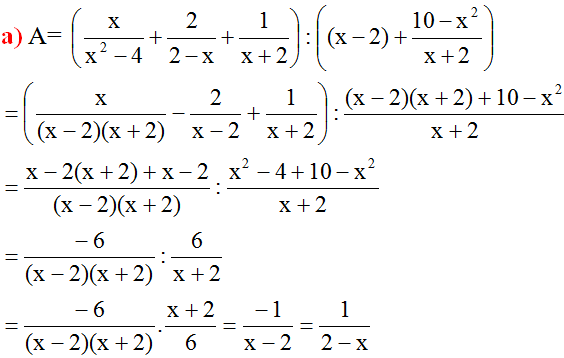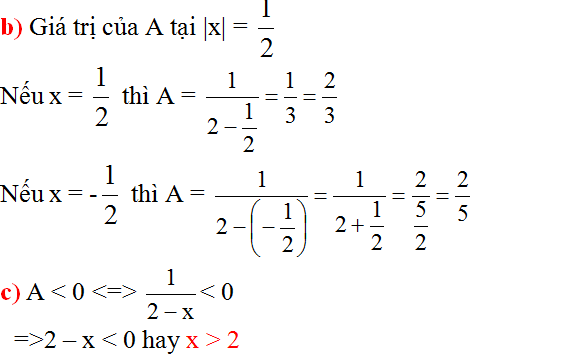Hãy nhập câu hỏi của bạn vào đây, nếu là tài khoản VIP, bạn sẽ được ưu tiên trả lời.

\(ĐKXĐ:x\ne-3;2\)
\(\frac{x+2}{x+3}-\frac{5}{x^2+x-6}-\frac{1}{x-2}=\frac{x+2}{x+3}-\frac{5}{\left(x+3\right)\left(x+2\right)}-\frac{1}{x-2}\)
\(=\frac{x^2+4x+4}{\left(x+3\right)\left(x+2\right)}-\frac{5}{\left(x+3\right)\left(x+2\right)}-\frac{x+3}{\left(x+2\right)\left(x+3\right)}\)
\(=\frac{x^2+4x+4-5-x-3}{\left(x+2\right)\left(x+3\right)}=\frac{x^2+3x-4}{\left(x+3\right)\left(x+2\right)}=\frac{\left(x+4\right)\left(x-1\right)}{\left(x+3\right)\left(x+2\right)}\)
\(x^2-9=0\Leftrightarrow x=3\left(vì:x\ne-3\right)\)
\(\Rightarrow P=\frac{7}{15}\)
\(P\inℤ\Leftrightarrow x^2+3x-4⋮x^2+5x+6\Leftrightarrow2x+10⋮x^2+5x+6\Leftrightarrow12⋮x^2+5xx+6\)
\(................\left(dễ\right)\)
P/s: shitbo sai rồi nha bạn!Nếu không tin thì thay x = 3 vào P ban đầu và giá trị P sau khi rút gọn sẽ thấy sự khác biệt =)
ĐK: \(x\ne-3;x\ne2\)
a) \(P=\frac{x+2}{x+3}-\frac{5}{x^2+x-6}-\frac{1}{x-2}\)
\(=\frac{x^2-4}{\left(x+3\right)\left(x-2\right)}-\frac{5}{\left(x-2\right)\left(x+3\right)}-\frac{x+3}{\left(x-2\right)\left(x+3\right)}\)
\(=\frac{x^2-x-12}{\left(x+3\right)\left(x-2\right)}=\frac{\left(x-4\right)\left(x+3\right)}{\left(x+3\right)\left(x-2\right)}=\frac{x-4}{x-2}\)
b) \(x^2-9=0\Leftrightarrow x^2=9\Leftrightarrow x=\pm3\)
Thay vào điều kiện,tìm loại x = -3 .Tìm được x =3
Ta có: \(P=\frac{x-4}{x-2}=\frac{3-4}{3-2}=-1\)
c)Ta có: \(P=\frac{x-4}{x-2}=\frac{x-2-2}{x-2}=1-\frac{2}{x-2}\)
Để P có giá trị nguyên thì \(\frac{2}{x-2}\) nguyên hay \(x-2\inƯ\left(2\right)=\left\{\pm1;\pm2\right\}\)
Suy ra \(x=\left\{0;1;3;4\right\}\)

Lời giải của bạn Nhật Linh đúng rồi, tuy nhiên cần thêm điều kiện để A có nghĩa: \(x\ne\pm2\)

Bài 1 rút gọn bc tự làm :
\(B=\dfrac{3y^3-7y^2+5y-1}{2y^3-y^2-4y+3}\)
\(B=\dfrac{3x^3-3y^2-4y^2+4y+y-1}{2y^3-2y^2+y^2-y+3y-3}\)
\(B=\dfrac{3y^2\left(y-1\right)-4y\left(y-1\right)+\left(y-1\right)}{2y^2\left(y-1\right)+y\left(y-1\right)-3\left(y-1\right)}\)
\(B=\dfrac{\left(3y^2-4y+1\right)\left(y-1\right)}{\left(2y^2+y-3\right)\left(y-1\right)}\)
\(B=\dfrac{3y^2-3y-y+1}{2y^2-2y+3y-3}=\dfrac{3y\left(y-1\right)-\left(y-1\right)}{2y\left(y-1\right)+3\left(y-1\right)}\)
\(B=\dfrac{\left(3y-1\right)\left(y-1\right)}{\left(3y+2\right)\left(y-1\right)}=\dfrac{3y-1}{3y+2}\)
Bài 2 )
a ) \(x+\dfrac{1}{x}=3\)
\(\Leftrightarrow x^2+2x\dfrac{1}{x}+\dfrac{1}{x^2}=9\)
\(\Leftrightarrow x^2+\dfrac{1}{x^2}=1\)
b ) \(\left(x+\dfrac{1}{x}\right)^3=27\)
\(\Leftrightarrow x^3+\dfrac{1}{x^3}+\dfrac{3}{x}+3x=27\)
\(\Leftrightarrow x^3+\dfrac{1}{x^3}+3\left(\dfrac{1}{x}+x\right)=27\)
\(\Leftrightarrow x^3+\dfrac{1}{x^3}=18\)





a, Để B xác định
\(\Leftrightarrow\left\{{}\begin{matrix}x-2\ne0\\x+2\ne0\\4-x^2\ne0\end{matrix}\right.\Leftrightarrow\left\{{}\begin{matrix}x\ne2\\x\ne-2\end{matrix}\right.\)
\(b,B=\dfrac{3}{x-2}+\dfrac{-2}{x+2}-\dfrac{x-14}{4-x^2}\)
\(=\dfrac{3\left(x+2\right)}{\left(x+2\right)\left(x-2\right)}+\dfrac{-2\left(x-2\right)}{\left(x+2\right)\left(x-2\right)}+\dfrac{x-14}{\left(x-2\right)\left(x+2\right)}\)
\(=\dfrac{3x+6-2x+4+x-14}{\left(x+2\right)\left(x-2\right)}\)
\(=\dfrac{2x-4}{\left(x-2\right)\left(x+2\right)}=\dfrac{2\left(x-2\right)}{\left(x-2\right)\left(x+2\right)}=\dfrac{2}{x+2}\)
c, Đẻ B có giá trị nguyên
\(\Leftrightarrow2⋮x+2\Leftrightarrow x+2\inƯ\left(2\right)=\left\{1;-1;2;-2\right\}\)
Ta có bẳng sau:
Vậy \(x\in\left\{-1;-3;0;-4\right\}\) thì B có giá trị nguyên